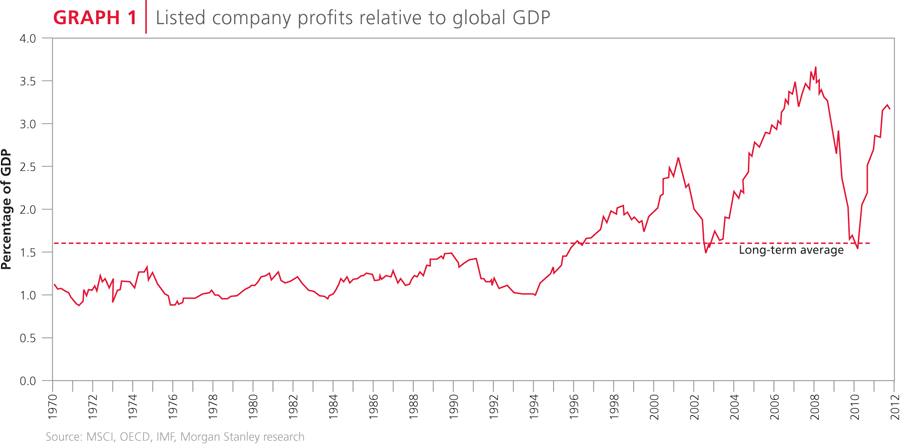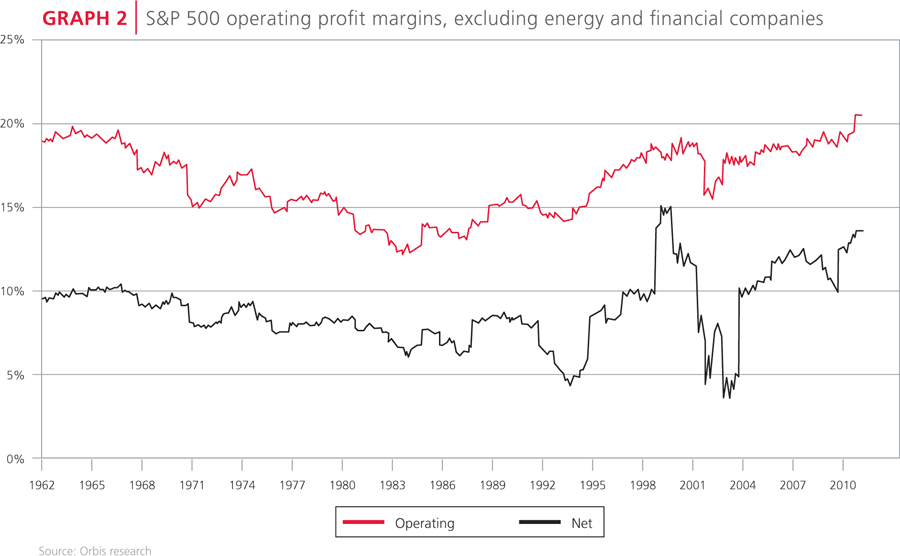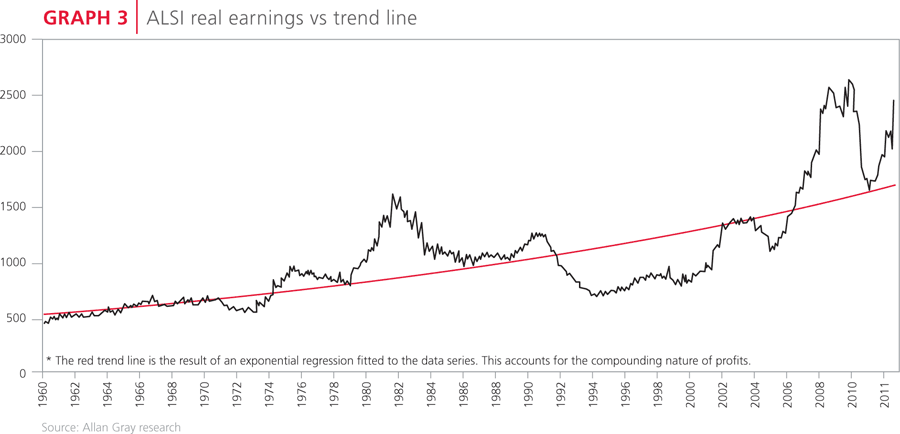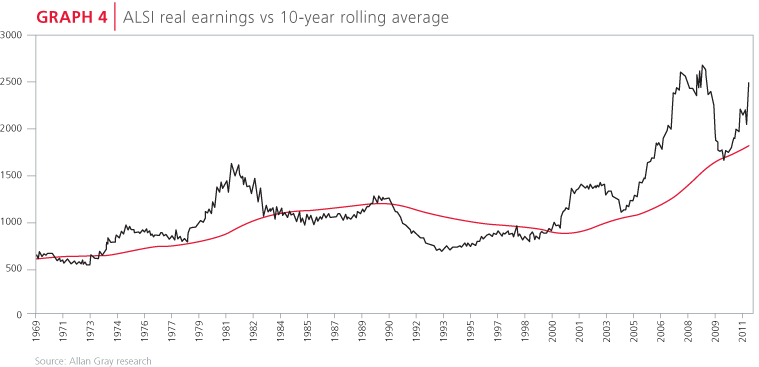Company profits are currently at historic highs, but we do not know with any certainty where they are headed. Although it is entirely possible for global and South African profit levels to remain elevated for quite some time, the unfortunate reality is that profits usually return to historic averages. To bet on profits remaining high into perpetuity would be to disregard the 50 years of earnings history we have on South African businesses. Simon Raubenheimer discusses.
One of the most noteworthy features of financial markets today, is the extraordinary level of profitability enjoyed by many companies around the world. This is in stark contrast to the continuous bad economic news we are barraged with on a daily basis. Yet high company profits are a reality for both developed and emerging countries. Profits in aggregate are consuming a near record portion of global GDP (see Graph 1). Operating profit margins for the S&P 500, excluding the volatile financial services and energy companies, are at their highest levels in at least 50 years (see Graph 2).
There are numerous reasons why global profitability has grown so much. Companies in many developed countries have benefited from falling effective personal and corporate tax rates, which have boosted earnings. An unpredictable and subdued economic climate has resulted in companies, particularly in Europe and the US, being cautious with their retained capital, using it to pay off debt rather than committing to significant capital investments. Combined with falling interest rates, this has led to lower interest costs. Furthermore, with real unit labour costs in the US now at 60-year lows, profits have grown to a large extent at the expense of wages in the developed world.


South African company profits are acutely high
Graph 3, shows real earnings, or profits, of South African listed companies using the FTSE/JSE All Share Index (ALSI) over the past 52 years.
The following observations are immediately apparent:
- Profits grow in real terms, in other words, by more than inflation: Over the past 52 years, earnings for listed companies in South Africa in aggregate have grown by 3.3% above inflation.
- Profits are cyclical: As our offshore partner, Orbis, noted in a recent Quarterly Report: ‘Profit margins rise and fall with the ebb and flow of competition and economic cycles.’ To determine a normalised level of earnings, we have fitted a trend line to Graph 3. Historically, profits above this trend line have proved to be unsustainable and always come back down to meet the trend line, and vice versa.
Our concern is that current reported profits are 45% above the long-term trend line. Earnings have only been higher than they are today 9% of the time, relative to the trend line. A similar picture emerges when we compare current profits to the average of the trailing 10-year inflation-adjusted profits (see Graph 4).


On this basis, profits are 37% above the 10-year rolling average.
There are a number of explanations as to why South African listed companies are currently so profitable. Two important reasons are:
- Over the past 10 to 15 years, an environment of falling inflation rates, falling interest rates and strong domestic asset prices (both stock markets and real estate) has provided a near-perfect backdrop for consumer expenditure. Net household debt to disposable income in South Africa has grown from just over 50% to almost 80% over the past decade. For many years, consumer credit extension grew by over 20% per annum. Real wage growth in South Africa, particularly in the public sector, has been strong. This has benefited numerous domestic retail and financial consumer businesses.
- With resource companies accounting for almost 40% of the ALSI, the rise in commodity prices over the past decade has had tremendous impact on aggregate ALSI profits. For example, a basket of commodities consisting of copper, iron ore, oil, metallurgical coal, zinc, aluminium and nickel, as produced by BHP Billiton, has risen almost fivefold in real terms since the early 2000s. This has enabled BHP’s profits to grow tenfold over the same period.
Where to from here for profits?
While we can assert that profits are high in an historical context, we do not know with any certainty where they are headed. It is entirely possible for global and South African profit levels to remain elevated for quite some time. However, there are various threats worth bearing in mind:
Consumers are heavily indebted. Debt servicing costs to disposable income are not low, despite the record low interest rates. The introduction of the National Credit Act in 2007 has become, and will continue to be, a much warranted headwind for consumer activity. Asset prices – both the stock market and house prices – are not rising at the rates they were for the past decade, and bank lending has slowed.
Meanwhile, at current commodity prices, the returns on capital generated by the global miners are very high. The potential supply of certain commodities such as iron ore (30% of Anglo American and 40% of BHP Billiton profits), manganese or thermal coal is virtually unconstrained over the long term. With the only barrier being the capital required to build mines and surrounding infrastructure, it is only a matter of time before the supply will rise to meet the projected demand. As we highlighted in our previous issue of Quarterly Commentary (Q2 2011), the combined capital expenditure of four big global miners, namely BHP Billiton, Anglo American, Vale and Rio Tinto, is likely to exceed US$50 billion next year. Adjusted for inflation, this is more than 10 times what they spent in 2000. Paradoxically, the best cure for high commodity prices may be high commodity prices.
The basic mechanisms of market economics mean that profits are mean reverting. Higher profitability begets competition, which drives down returns, and so the cycle continues. To bet on profits remaining high into perpetuity would be to disregard the 50 years of earnings history we have on South African businesses.
We continue to follow our investment philosophy.
As always, we think it is appropriate to invest in companies that have meaningful pricing power and are able to maintain their profitability in an environment where profits may be pressurised. Unsurprisingly, this characterises many companies in our top 10.
To bet on profits remaining high into perpetuity would be to disregard the 50 years of earnings history we have on South African businesses
The market as a whole is currently selling for 12.5 times trailing profits. This price to earnings multiple is not far from the 50-year average multiple of 11.9 times, therefore current company valuations appear reasonable at first glance. However, the risk is that the current high level of company profits proves unsustainable and that company profit levels head back to historic norms and act as a significant drag on expected returns from our equity market.